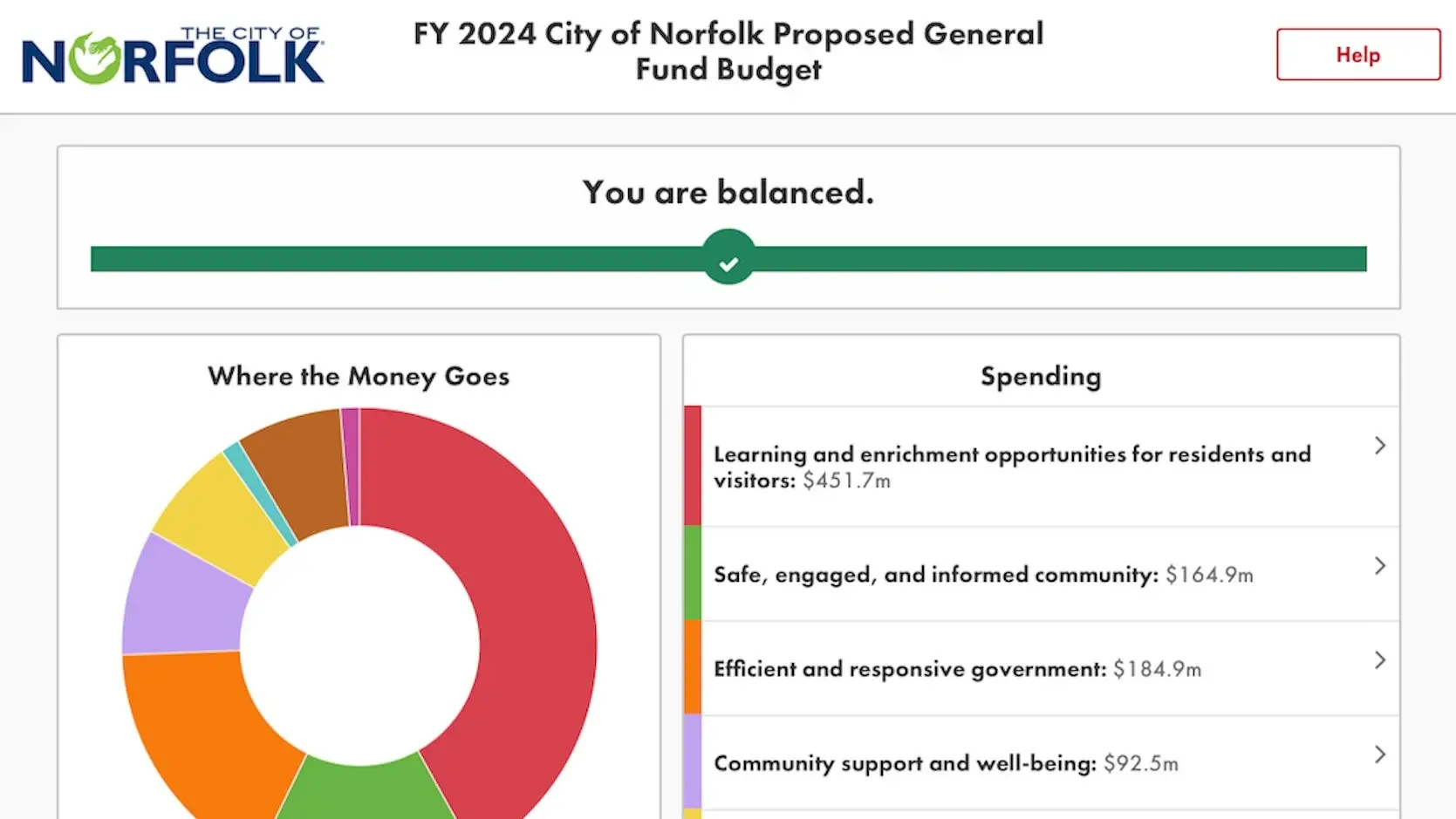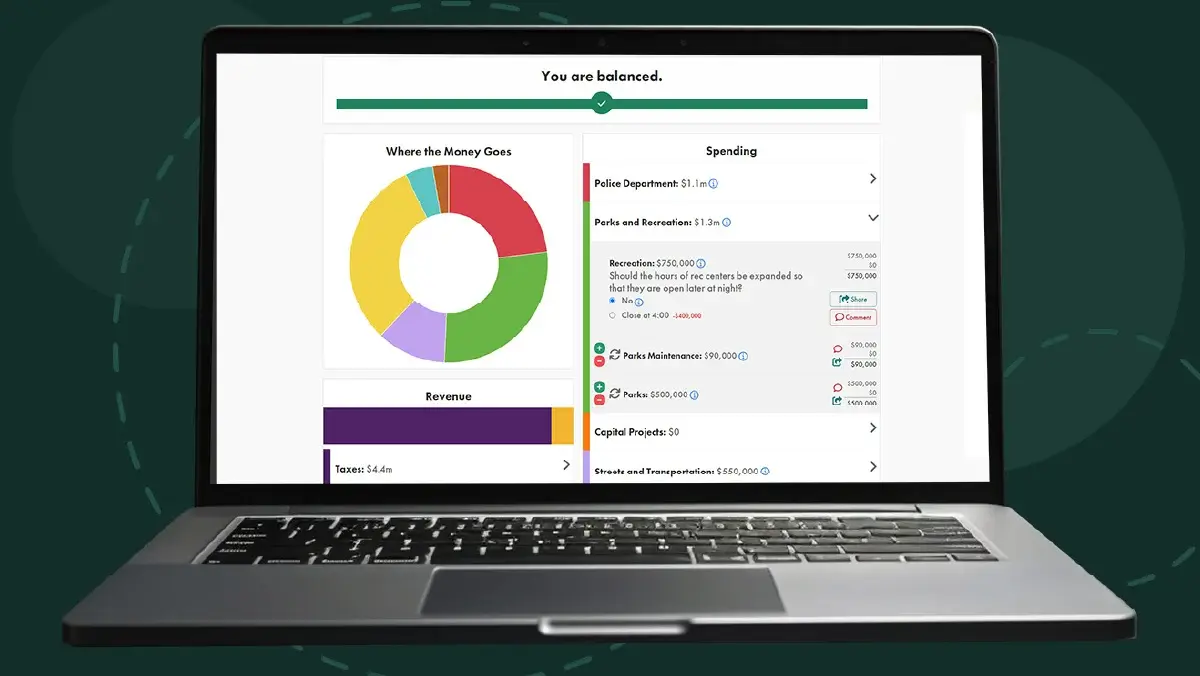Lawrence Makes Innovative Use of Balancing Act Software to Educate and Engage Residents About Budget Trade-Offs
By Polco on June 10, 2024

Photo credit: @ExploreLawrence Instagram
See how the Kansas city taught its residents about how the budget works and received quality data on the community's budget priorities.
Introduction
With a vibrant, passionate citizenry, the City of Lawrence, Kansas, is committed to listening, sharing, and engaging with its community to drive action and build trust in government. The City leveraged a budget simulation tool to help the community participate in city budget decision-making. As Lawrence began preparing its budget simulation using software from Balancing Act from Polco, it saw an opportunity to incorporate qualitative elements to help bridge the gap between government decisions and community understanding.
Background: Pushing the Software to Build Community Understanding
Lawrence decided to use its budget simulation software in new ways to demystify complex budget data and make the process more meaningful for the community.
“The budget is one of our most important deliverables, but it’s complex,” said Hannah Ballard, community engagement champion for Lawrence. “That’s why we wanted to create service-level rubrics to better demonstrate what it means, in plain language, to add or detract from any given program.”
The city set out to use the Balancing Act tool to show community members how changes in allocations of money translate into changes in service levels, transforming budget engagement into more of a quantitative, rather than a qualitative, exercise.
Rubric Creation Requires Team Involvement
To achieve this, cross-departmental teams collaborated to translate budgetary decisions into tangible impacts on service levels. They aimed to provide the community with a narrative—a story behind the numbers—showcasing the trade-offs inherent in budget decision-making.

Creating service-level rubrics proved to be a complex task that required extensive collaboration, numerous meetings, and intentional facilitation to break down departmental silos. The challenge was to distill technical jargon and acronyms into language accessible to the public. The process, though time-consuming, facilitated internal communication, fostering a shared understanding of the various services provided by different departments.
“It was very helpful to us internally,” Ballard said. “It allowed us to build understanding across department and have more meaningful conversations about where we are now and where we want to go.”
For users of Lawrence’s budget simulation, the rubrics enabled them to adjust revenue and expense categories according to their priorities, with each budgetary program assigned a current service level. Service levels went from “Service Level 1” representing the lowest level of city service to “Service Level 5” representing the highest level of service. For example, under “Safe and Secure,” users could select “Fire Medical Department - Operations” and maintain the current Service Level 4, which includes full-time paid operations staff, some volunteer auxiliary staff, and several other services. Or they could raise or lower the service level, which requires trade-off decisions to balance the budget.
“Overall, we’re delighted with the progress we made in our budget engagement program both internally and externally, and we’re looking forward to continuing to fine-tune those rubrics and make them even more useful to the community,” Ballard said.
Launch and Iterative Process
Lawrence’s budget engagement initiative officially launched in the spring of 2023 with a press release, email blasts, social media posts and local newspaper coverage to reach the community. The process involved ongoing refinement based on feedback from internal staff, elected officials and the public. The engagement process included not only input from the external public but also internal staff and elected officials participating in the simulation.
This three-pronged approach provided a comprehensive view of community preferences and priorities. The city received nearly 300 responses, providing valuable insights into the community's desires regarding budget allocations, and wrapped up its budget season in August.
“I think everyone was excited to have this new tool and new way of inviting people into one of the most complicated and important things we do, which is our city budget,” Ballard said.

Community Focuses on Housing and Homelessness
Balancing Act is a tool to not only collect data but also to inform decisions that align with the community's priorities. The tool allowed Lawrence to navigate a complex landscape of diverse opinions and conflicting needs, especially around affordable housing and homelessness.
The budget team presented the simulation results to the City Commission in the summer, which showed the community prioritized affordable housing and programs for unhoused individuals above other services. As a result, the city allocated dollars to a new homeless programs department, while decreasing funding in other areas.
“Our community told us that they want to see more investment in the housing and homelessness space,” Ballard said, “we heard that through the budget engagement process and other public participation initiatives, and we acted on it.”

Looking Ahead
Ballard notes that Lawrence's approach to budget engagement aligns with its strategic plan by emphasizing outcomes and commitments rather than traditional line-item budgeting.
“Our strategic plan is incredibly important to the organization,” Ballard said. “To be able to use this public-facing engagement tool to further our community’s understanding of the strategic plan was really important to us.”
The effort also reflects a commitment to creating a shared understanding between staff, elected officials and the community. The city’s budget engagement initiative is an ongoing, iterative process. The goal is to shift the community's involvement from reactive last-minute engagement to proactive participation earlier on. This year’s engagement effort led to a quieter, less controversial budget season, Ballard said, which demonstrated the effectiveness of the budget simulation tool in channeling community input at the beginning of the decision-making process.

Conclusion
As the city continues to refine its approach and structure, the aim is to harness the energy and commitment of its passionate community in co-creating a more responsive and inclusive local government.
Residents learned from the exercise that “there are tradeoffs in every budgetary decision that we have to make,” Ballard said. “Balancing the budget is tough work, and we need the input and engagement of our residents as we seek to build a more equitable, inclusive community where all people can enjoy life and feel at home.”
Through the innovative use of Balancing Act and the creation of service level rubrics, the city successfully navigated challenges, engaged its community earlier in the decision-making process and aligned its budget decisions with strategic priorities. Lawrence's journey is redefining the relationship between local government and residents to build a more inclusive and informed decision-making process.
Ready to Launch a Budget Simulation in Your Own Community?
Many governments are looking for a better way to engage their residents in building better budgets. With the Budget Simulation, you can collect data on financial priorities while educating users on how the budget works and what actions are possible. Get the Budget Simulation to increase transparency, budget awareness, and make more informed financial decisions for your community!
Popular posts
Sign-up for Updates
You May Also Like
These Related Stories

Norfolk’s Budget Engagement Increases Resident Understanding of the “Delicate Reality of Allocating Funding”

Interactive Budget Simulations: A New Era of Public Engagement


